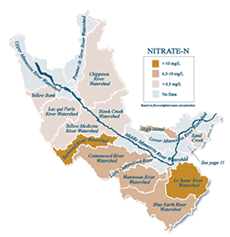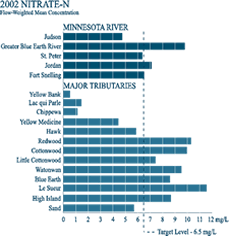Nitrate-Nitrogen in the Minnesota River Basin
|
Elevated nitrate levels in the Minnesota River contribute |
||||||
|
||||||
  |
What is the status of nitrate-nitrogen in the Minnesota River BasinIn recent decades, there has been a substantial increase in nitrogen fertilizer use. Elevated nitrate-N in the Minnesota River can pollute aquifers it recharges. Therefore, nitrogen can affect drinking water. The map and chart at left illustrate the nitrate-N levels in 2002 for selected Minnesota River Basin watersheds. They show flow-weighted mean concentrations of nitrate-N. This is equivalent to routing all of the flow that passed a monitoring site during a specific timeframe into a big, well-mixed pool, and collecting and analyzing one sample from the pool to give the average concentration. Monitoring indicates that flow-weighted mean concentrations of nitrate-N are greater than, or very near, the 10 mg/L drinking water standard in several major tributaries starting at the Redwood River and continuing downstream. Concentrations in these tributaries stand in sharp contrast to tributaries in the upper part of the Basin where concentrations are much lower (see map) and they underscore the need for effective BMPs that can reduce nitrate-N in streams. The Greater Blue Earth (GBE) River stands out with the greatest flow-weighted mean concentration values for nitrate-N. These values have been nearly constant from 2000-2002 (9.78-9.95) despite substantial year-to-year differences in precipitation and runoff. The nitrate-N laden water of the GBE River joins the Minnesota River at its confluence at Mankato, increasing the nitrate-N FWMC of the Minnesota River. |
|||||
What are the downstream impacts of elevated nitrate-nitrogen levels?Downstream, nitrate-N from the Minnesota River contributes to the dead zone (or zone of hypoxia), an area with low levels of dissolved oxygen in the Gulf of Mexico. According to the U.S. Geological Survey, annual loads of nitrates discharging into the Mississippi River have nearly tripled in the last 30 years. The Minnesota River has been identified as one of several relatively high contributors of nitrogen into the Mississippi River. Thus, according to the Minnesota Pollution Control Agency, the Minnesota River may be at least partly responsible for this problem.Learn more about downstream impacts. When the Mississippi River flows into the Gulf of Mexico, it creates a massive area devoid of marine life called the Dead Zone. Each summer the nutrients carried by the Mississippi River promote large algal blooms in the Gulf. In particular, excess nitrogen from the Mississippi River contributes to high rates of algae growth, and subsequent oxygen depletion when the algae die and decompose. This oxygen depletion results in an area devoid of marine life called the dead zone. A recent map shows this area of low oxygen covering more than 6,000 square miles - an area roughly the size of New Jersey. It stretches from the Mississippi River to Texas. The size of the dead zone has more than doubled in size in the early 1990s. For more information on the Dead Zone, visit the Science Museum of Minnesota's interactive Dead Zone web site: http://www.smm.org/deadzone/ References: |
||||||
|
This page was last updated 9/15/04 |
||||||

